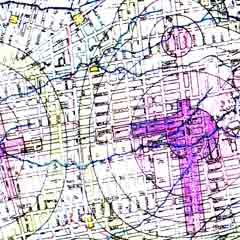BUILDING ECOCITIES:
An Interview with Richard Register
January, 2000
Part one of a three-part series - Page 3 of 3
ECOTECTURE: Do you have an idea as to how small that amount of land could be?
RR: I would guess it would run from 10 percent to 25 percent of the land area, without being radically three dimensional like Paolo Soleri's Arcology idea. His idea is to create cities that are in a single structure, like an Indian pueblo, for example. But he has different, modern designs for what that might look like. It is the idea of a whole city that is a three dimensional lattice work of habitations and work spaces is what he is thinking about.
Even shy of that I think you would be building cities on one tenth to one quarter of the land that is now occupied by cities. Just look at the difference between Phoenix and Boston, for example, there is a seven to one ratio in density there. Boston is 14 percent the land area of Phoenix. To say you could get down to 10 percent maybe isn't that radical.
ECOTECTURE: Yet Boston doesn't strike one as so impossibly dense of a city that one wouldn't want to live there.
RR: Well, a lot of people love living there. Obviously there is a different attitude about living in Boston than living in the suburbs some place far from the city. But, we are building for the future in any case. What we are designing, thinking about, and building right now is only going to slowly come about. So, our children are likely to have a different attitude about how they want to live than we might want them to live, or, than we want to live anyway. So, it would make some sense, since it takes decades to build cities, to think through giving them another option and see if they like it.
Right now, the subsidies go the the sprawled city. Subsidies go to the freeways and the oil depletion allowances so you can get your gasoline cheaper and so on. We are used to that. We could be giving the subsidy to low income housing and student housing in the middle of downtown, and transit. But, we are choosing right now to give most of the subsidies to the big money folks.
Berkeley, for example, rezoned its western section in its "West Berkeley Plan," a few years ago, and now we have built between five and seven thousand parking places in West Berkeley. I used to think it was a little bit less, but I have just taken a tour of West Berkeley this morning, driving out there to visit a creek I'm working on, and it's awesome. They have put in lots of new places there, lots of new shops, offices, some cleaner industry, and gigantic parking lots to serve it all in the open space that was there just ten or fifteen years ago. It's part of a plan to get more tax base in the City of Berkeley, and it's working. People make money on car infrastructure.
There is an enormous subsidy right now to continue building the automobile infrastructure. If we are thinking about a healthier way to build, an ecologically healthier way in my mind, where is the money for it? We can make these decisions, but, basically, society isn't making these decisions very well.
ECOTECTURE: Do you think it would be fair to say that we probably have most of the knowledge base we need to accomplish the ecological rebuilding of cities, but it is more a question of education, money, and politics? Or, do you think that there's new technological breakthroughs or new knowledge that we need to have?
RR: I think we don't have the right knowledge available to most people. I think I have the knowledge and the people who go to these International Ecocity Conferences have some knowledge about it. Then there are some people who are getting kind of close, like the New Urbanists who talk about their transit oriented centers, which is helpful, heading in the right direction-there is some knowledge there.
The knowledge that is missing is what I sometimes call "ecocitology" the art and science of building ecological cities, understanding what they are. There's a whole system of thinking there that evolves from those principles I mentioned, the first two of which are the three dimensionality and the fitness with evolution, that cities should be informed by. That is the foundation of the knowledge of ecological city design. The rest is details. The details are all important, and that is where you add in your permaculture, passive solar buildings, and all sorts of things that make enormous amounts of sense-transit, bicycles, creek restoration and so on. It could be done in a very beautiful way that really serves lots of people.
ECOTECTURE: How would you make that beautiful?
RR: In all sorts of ways. I think there is a real challenge here with roof-top gardens, public spaces up high with great views, the kind of planting you bring into those areas. I think you really should respect some of the architectural heritage of the city in what you are building as new stuff.
You might want to try to devise an ecological aesthetic too, an aesthetic that celebrates an ecological life. Humming birds, butterflies, song birds- you can actually do plantings to attract them, design your buildings with terracing. You and I were out on the terrace of my apartment a few minutes ago. It is a microsopic terrace here. Those little outdoor places would be considerably larger than the terrace we have at this little flat. People could have plots of land up in the air. Features like bridges between buildings and pedestrian passsageways in the middle of blocks down on ground level-these things turn the city into a sort of a playground. They work really well in malls all over the world, they work in areas like San Francisco's Pier 39, commercial areas. There are many places where people love to be in pedestrian environments. You can work with that in higher density and do it effectively.
How to do it in a beautiful way? I might point out that we have this democracy of the lowest common denominator in this country where everybody's house is the same size in suburbia, which means you don't get a view, unless you are up on a steep hill. The house across the street, like the house across from this one, is the same height, so you can't see the (San Francisco) Bay. You have all the trees and houses in each other's way. To actually have a view, you have to rise up a little bit higher, so your view started about the third or forth floor here. But no one is allowed to build that high in Berkeley. So, everybody is equal, nobody gets the view-unless you are rich and live in a place up in the hills, in Berkeley, anyway. In other words, one of the aesthetic solutions is the more attractive, taller building which provides not only what could be the beauty of the building itself, but, also, lets you get up in the air where you can look around and see the beauty of your natural bioregion.

